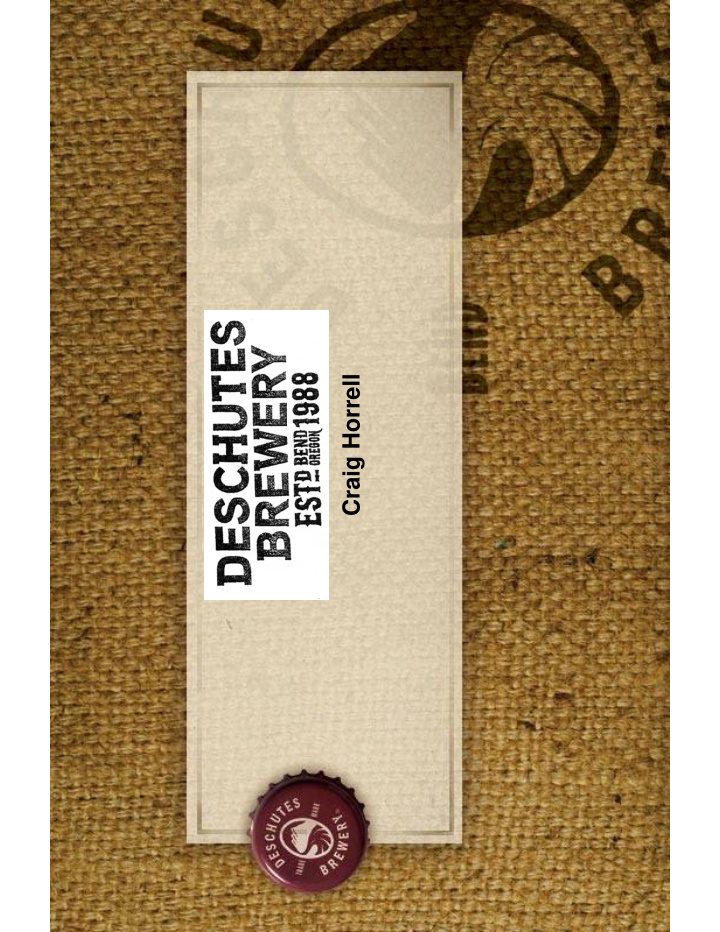



Craig Horrell
Where We Live
Portland Pub Opened 2008 The Portland pub has used PGE’s 100% renewable energy since the day it opened. It also features a collection of large salvaged timber beams used to build the bar, tables and other parts of the building. Bend Pub Opened 1988 Newly Expanded 2012 Both the Bend and Portland pubs participate in recycling and composting programs and purchase locally farmed beef raised on Deschutes’ spent grain.
Deschutes Brewery’s Brewing Facility 2011 Fermentation Expansion June 2012 Bend, Oregon
2012 DESCHUTES BREWERY SALES BY STATE
Water Source • This system derives 50% of its water from Bridge Creek, a headwater tributary of Tumalo Creek, and the remaining 50% from groundwater. • Annual snowmelt and precipitation supplies the aquifer with an average recharge of 3800 cubic feet per second (cfs) annually. Averaged over the year that is about 2.4 billion gallons per day of recharge to the aquifer. • The City of Bend’s groundwater supply consists of nine well fields. Well depths range from 400 ft to 1000 ft. The water quality of these wells is very similar to our surface source. These wells are used to meet peak summer demand and supplement surface water source when quality is not acceptable due to turbidity from snow melt or heavy precipitation.
Water Use • In 2013, the Deschutes Brewery Plant withdrew 37,223,686 gallons of water from the City of Bend’s municipal water system. • The annual average water consumed per barrel of beer packaged for 2013 was 4.31 gallons. While we did not meet our goal of 4.0 gallons per barrel packaged we did improve on the 2012 usage of 4.33 gallons by 0.5%. • We have documented a reduction in our water use per barrel packaged from 4.4 gallons in 2009 to 4.31 gallons in 2013.
• Deschutes Brewery has pledged to contribute 1 billion gallons of water to the Deschutes River annually on a multi-year basis (5 years +) with a large donation to the Deschutes River Conservancy to support instream leasing of water rights through the DRC’s leasing program • DRC’s Instream Leasing Program pays farmers and other surface water users to lease instream, legally protecting that water in the middle Deschutes River. • Benefitting: fish, wildlife, aquatic life, water quality, people, recreation, fishing, tourism, water right holders, landowners, irrigation districts, our local economy, and more! • 1 billion gallons of water is 14 x what Deschutes Brewery water use is in total: including bottling facility, brewery pubs, supply chain, hops growers, grain growers, etc
1 billion gallons is VERY significant for our Deschutes River – 3,069 acre-feet (picture an amount of water 1 foot deep covering 2,785 football fields or filling 1,668 Olympic size swimming pools!) – 563 acres leased (average Deschutes farm takes 5.45 acre-feet/acre) – Close to 7% of restoration on the middle Deschutes River – Over 10% of the total in stream leasing program
Plant Waste Stream – 60% +/- of the incoming water is packaged in product. The other 40% is in the waste stream, steam or evaporation. – We Have four waste streams at our plant. • High strength • Low Strength • Spent grain • Sanitary – Our permit with the City of Bend allows us to discharge 3,600 ppd of COD at a pH range of 6.0 to 10.0 from 11:30pm to 10:00am. So how do we do this with the volume of beer we produce?
High Strength Waste • We separate very high organic load materials into a different drain system than our low strength and sanitary wastewater. • This is trucked off by a local company: • Agricycle spreads 375,000 gallons a month as a soil amendment on local fields. • This fertilizer is very effective because of nutrients, it is a byproduct, so it takes no extra energy to make and it is cheaper for local farmers.
Low Strength Waste • Our low strength and wastewater is separated and sent to the WTF?! (Waste Treatment Facility). It is then treated for pH and stored for discharge to the City. • We store and treat for pH 80,000 to 110,000 gallons a day. • We release to the City between the hours of 11:30 pm and 10:00 am. This allows us to release at 200 gpm with a 3,600 PPD COD maximum.
Spent Grain • Spent grain is trucked off and sold as cow feed all over Oregon. • Any spent hops used in the hot side of the brewing process are combined with this spent grain from the brewhouse. • Keeps anyone from having to process it, generates revenue for the Brewery, and is a healthy food for the cows. • Pub spent grain goes to Borlen Cattle Company. They are very local. They feed their cows with it, and then we buy the beef back from them and serve it in the pub burgers.
Spent Yeast • High strength waste would still be a good fertilizer, and we would avoid having too much volume to get rid of locally. • Right now it goes to high strength waste. • This year or next we want to separate it out, as well, and sell it as cattle feed. • Very good vitamins and nutrients for animals.
Questions?
Recommend
More recommend